 Cleaning the front engine, the Prelude 2.0 four cylinder engine, in the rain. Neither the front nor the rear engine needed to be rebuilt; they both ran well, and I didn't want to spend either the time or the money.
Cleaning the front engine, the Prelude 2.0 four cylinder engine, in the rain. Neither the front nor the rear engine needed to be rebuilt; they both ran well, and I didn't want to spend either the time or the money.
 Jonathon and I replaced all the belts and thoroughly cleaned, detailed and painted the engine.
Jonathon and I replaced all the belts and thoroughly cleaned, detailed and painted the engine.
 It was pretty late by the time we got to installing it.
It was pretty late by the time we got to installing it.
 The next day, by daylight.
The next day, by daylight.
 cleaning the rear engine,the 1970 Cadillac 500 c.i. took hours. I was very thorough, though I didn't want to be. An unexpected side effect was that the detergents chewed up the asphalt. Out of respect to Cadillac, I chose to keep the engine and transmission blue.
cleaning the rear engine,the 1970 Cadillac 500 c.i. took hours. I was very thorough, though I didn't want to be. An unexpected side effect was that the detergents chewed up the asphalt. Out of respect to Cadillac, I chose to keep the engine and transmission blue.
 While painting the transmission chain cover, I couldn't resist taking a picture of the massive chain that links the torque converter with the mechanics of the Turbohydramatic transmission. I really admire this transmission. I bet when they designed it, there were 10 people who said "That'll never work." I've heard that before.
While painting the transmission chain cover, I couldn't resist taking a picture of the massive chain that links the torque converter with the mechanics of the Turbohydramatic transmission. I really admire this transmission. I bet when they designed it, there were 10 people who said "That'll never work." I've heard that before.
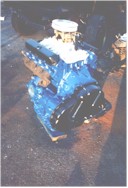 The rear engine, after cleaning and painting. What a monster. Let's hope it runs like it looks after the years of sitting around. I'm keeping the stock Rochester Quadrajet carburetor. It works well enough, so I'm not shelling out a quarter-gee for an aftermarket one. If I do any upgrades, I'll go straight to sequential port fuel injection and supercharging. I did feel that reducing the weight of the engine was justification for replacing the stock cast iron intake manifold with the Edelbrock 2115 manifold.
The rear engine, after cleaning and painting. What a monster. Let's hope it runs like it looks after the years of sitting around. I'm keeping the stock Rochester Quadrajet carburetor. It works well enough, so I'm not shelling out a quarter-gee for an aftermarket one. If I do any upgrades, I'll go straight to sequential port fuel injection and supercharging. I did feel that reducing the weight of the engine was justification for replacing the stock cast iron intake manifold with the Edelbrock 2115 manifold.
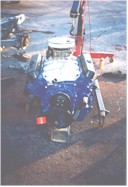 No fan, no alternator, no accessories, no need, no room .
No fan, no alternator, no accessories, no need, no room .

 Here's the engine, installed. It fits - just barely.
Here's the engine, installed. It fits - just barely. 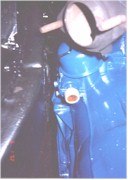 I needed a 3/4" disk to fill the speedometer cable hole. I used an American penny, a 1982D. I hope it's lucky.
I needed a 3/4" disk to fill the speedometer cable hole. I used an American penny, a 1982D. I hope it's lucky.
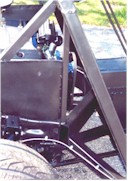 A little peek at the waterpump belt of the rear engine.
A little peek at the waterpump belt of the rear engine.
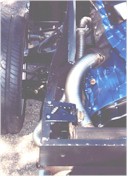 Some exhaust work is done. The suspension is shiny.
Some exhaust work is done. The suspension is shiny.
 This is the weak link in the rear drivetrain, the driveshafts from the 1985 Eldorado. Their worst case diameter is 1.1 inch, compared to 1.3 inch for the driveshafts which originally went with the engine. The smaller ones fit better, which is why they are used. The 0.2 inch difference in diameter results in a 40 percent decrease in the strength of the driveshaft. I've done the math, and these driveshafts will probably tolerate about 1100 poundfeet of torque before failing. Theoretically, the rear engine can easily exceed this after gearing, but I'm kind of hoping that transmission losses and rotational inertia of the rear engine might slow things down a little bit and let these driveshafts survive. It's gonna be close. If I do decide to eventually supercharge the rear engine, I will have to upgrade these driveshafts to something stronger.
This is the weak link in the rear drivetrain, the driveshafts from the 1985 Eldorado. Their worst case diameter is 1.1 inch, compared to 1.3 inch for the driveshafts which originally went with the engine. The smaller ones fit better, which is why they are used. The 0.2 inch difference in diameter results in a 40 percent decrease in the strength of the driveshaft. I've done the math, and these driveshafts will probably tolerate about 1100 poundfeet of torque before failing. Theoretically, the rear engine can easily exceed this after gearing, but I'm kind of hoping that transmission losses and rotational inertia of the rear engine might slow things down a little bit and let these driveshafts survive. It's gonna be close. If I do decide to eventually supercharge the rear engine, I will have to upgrade these driveshafts to something stronger.
 Forward to the Fuel System.
Forward to the Fuel System. Back to Index.
Back to Index.